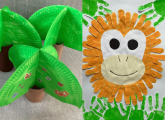In the second part of her series on schematic behaviour, Dr Frances Atherton explains how the observation of children’s schemas can provide valuable insights into their thought processes…
As I touched upon in my first article, through careful observation of young children – be it watching what they do or listening to what they say, actually taking notice of the particularities of their actions and talk – practitioners and parents alike can gain an insight into children’s thinking concerns. Observation is important: it allows for events to be witnessed that may otherwise be missed. To be open to what young children may reveal in their play, and accepting in terms of how their behaviours can enlighten us about their thinking, can be demanding of adults; but if we want to understand and are ready to reflect on and evaluate what we see, then real comprehension is possible – and young children’s remarkable capabilities become far more apparent with sensitive and attentive viewing by adults willing to spend the time it takes to really come to know them.
Peter Clough and Cathy Nutbrown suggest that in observing young children we should look “critically, openly, knowingly, for evidence, to be persuaded, for information” that would allow for a perceptive and profound view of young children’s thinking to be distinguished. This requires an openness and acceptance to reflect upon the behaviours that may unfold in our midst. The following observations of Patrick, Annie and Greg were taken of them immersed in their play, showing developments in thinking as the former pursued a dynamic vertical schema, and the two others are going through a boundary schema…
I observed Patrick exploring vertical, upright positioning with the things around him. He chose a xylophone and upended it; he sprinkled sand onto the floor, watching it drip through his fingers; he pushed toy cars up a slide and watched them roll down again; he built piles of blocks and stacked others on end into towers. He enjoyed action songs, joining in with Peter hammers with one hammer banging one fist up and down on the other. Dancing to another song, he held his arms in the air, bent his knees and bounced up and down. At snack time, he put a spoon on his head, dropped pieces of pear onto the floor and beat his fork on the tray. At the painting easel, Patrick stood the paint pots on top of each other: “I’ve got two paint pots,” he said (he had two pots at the time). “It’s high, it’s big”. Outside, he stood on top of the wooden crocodile, scrambled up the net into the climbing frame and down again, crawled up slides and scaled the rope ladder acquiring vertical trajectory motor experiences.
Patrick’s dynamic vertical schema can be seen in a series of actions where he used a variety of things around him in a fastidious up-and-down way. What was important to Patrick was to find things easily to hand with which he could explore upward and downward movements. The upright potential of the xylophone appeared more enticing than the musical, as with the paint pots, whose contents did not immediately tempt Patrick into expressing his artistic tendencies through mark-marking, but allowed for an altogether more appropriate (for him) expression of thinking. Patrick was able to explore verticality with items around him in a way which was of consequence to him. The content was diverse (sand, blocks, xylophones, slides, rope ladders, paint pots, pears, spoons), but the form of thinking was consistent with Patrick’s dynamic vertical schema.
Patrick’s unconventional use of the paint pots could be interpreted as mischievous, even disruptive, yet Chris Athey was placatory in suggesting that viewed through a schematic lens, seemingly unfathomable behaviour could be understood more favourably. Patrick’s use of the paint pots must be understood for the significant endeavour it actually was. The paint pots were employed by Patrick in a particular way in the exploration of his dynamic vertical schema at a symbolic level, and to have tolerated these seemingly inappropriate actions was important in the first instance and only possible by a knowledgeable and understanding accompanying adult. Offering children richly varied resources, and the time to work with them, supports their investigative propensities and nourishes them in their schematic pursuits, which is vital in enabling young children to flourish.
The observations capture Patrick working on his dynamic vertical schema but also disclose the holistic nature of his thinking and development as he played. With reference to the EYFS, the observations demonstrate the following characteristics of effective learning:
● Showing curiosity about objects;
● Using senses to explore the world around them;
● Showing particular interests.
Additionally, they demonstrate evidence of development from the areas of learning, including many examples from prime areas ‘personal, social and emotional development’, ‘physical development’ and ‘communication and language’; and specific areas ‘mathematics’, ‘understanding the world’ and ‘expressive arts and design’.
Chris Athey in her work described many motor level examples of ‘going through a boundary’ behaviour, which included children experimenting by pushing one thing through another. I observed Annie pushing her hand through a green hoop, poking her finger through the hole in the middle of a CD and through the gaps in a whisk. She pressed her fingers into a wicker ball and held the shaker by putting her fingers through the handle. Annie was exploring how one thing (fingers, hands) could go through another (green hoop, hole in CD, shaker handle).
She was furthering her knowledge of ‘going through’ in these motor level observations.
In pursuing her schema of ‘going through a boundary’ Annie was experiencing a range of ideas, including shape, size, rotation and space. The content again was disparate (hoops, CDs, whisks) but the prevailing form of thought, that of ‘going through’, was evident. These significant practical explorations create a foundation upon which new understandings can be built, with children able to make connections and form new ideas.
This could also be seen in Greg’s actions and speech as he worked on going through a boundary schema, which he coordinated with his other schemas, specifically containing and enveloping and dynamic vertical.
In using the things available around him (baskets, open mouths, buttons, chime bars, tambourines, suitcases); in his actions (dog inside toy basket, buttons through slats in the pet carrier, looking through the slats, peering down chime bars, gazing through tambourine holes, lifting up and pushing down handles of suitcases); and in his speech (“a tooth’s in there”, “he’s going in the basket now”) is suggested coordinated schematic behaviour. Through these schemas, Greg experienced several higher order concepts, including:
Size – when pulling the tambourine down over his head and resting it on his shoulders, Greg might have been thinking My head fits through the hole in the tambourine; and, when looking down the hole in the chime bar and through the middle of the tambourine, The hole in the chime bar is small but the hole in the tambourine is big.
Shape – when looking down the middle of the chime bar and holding the tambourine with two hands and putting it over his head, he might have been thinking The chime bar is round and long; the tambourine is round.
Force and speed – when pulling the handle of the suitcase up and pushing it back down, he might have been thinking If I pull the handle of the suitcase, it comes up and if I push it, it goes down. I can make the handle move quickly and slowly.
Height – when watching how he made the handle go up and down, he might have been thinking I can make the suitcase handle come halfway up or right up to the top.
Equivalence – when putting the toy dog in the basket, he might have been thinking Only one dog fits in one basket; and when putting the tambourine over his head, Only my head fits through the tambourine at once.
Next up, read Frances’ article on supporting children’s thinking as they play.
Frances Atherton is co-author with Cathy Nutbrown of Understanding schemas and young children: from birth to three.

Nature crafts – Make your own rainforest
Editors picks

Dyspraxia – Is it hiding in plain sight in early years?
Editors picks
